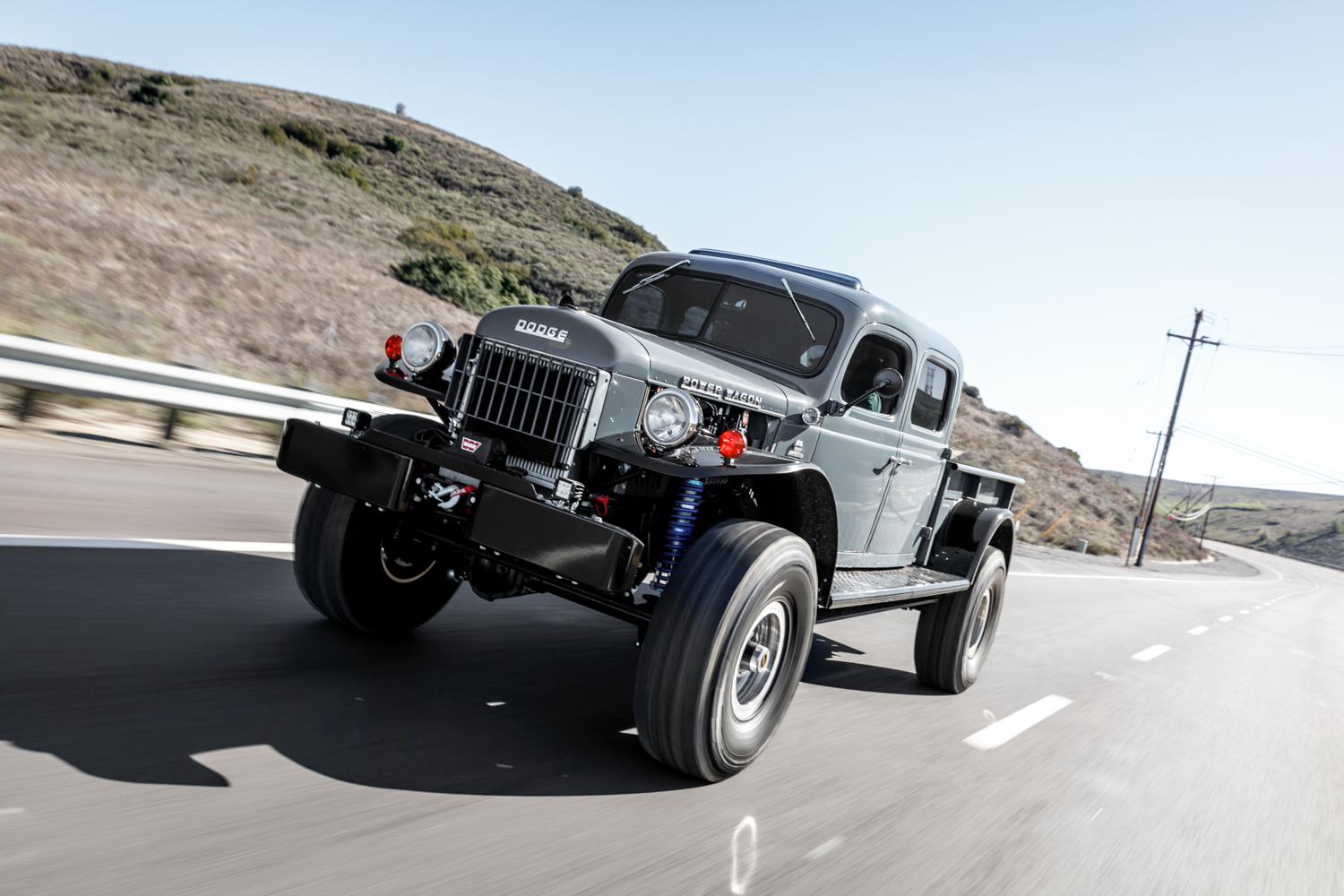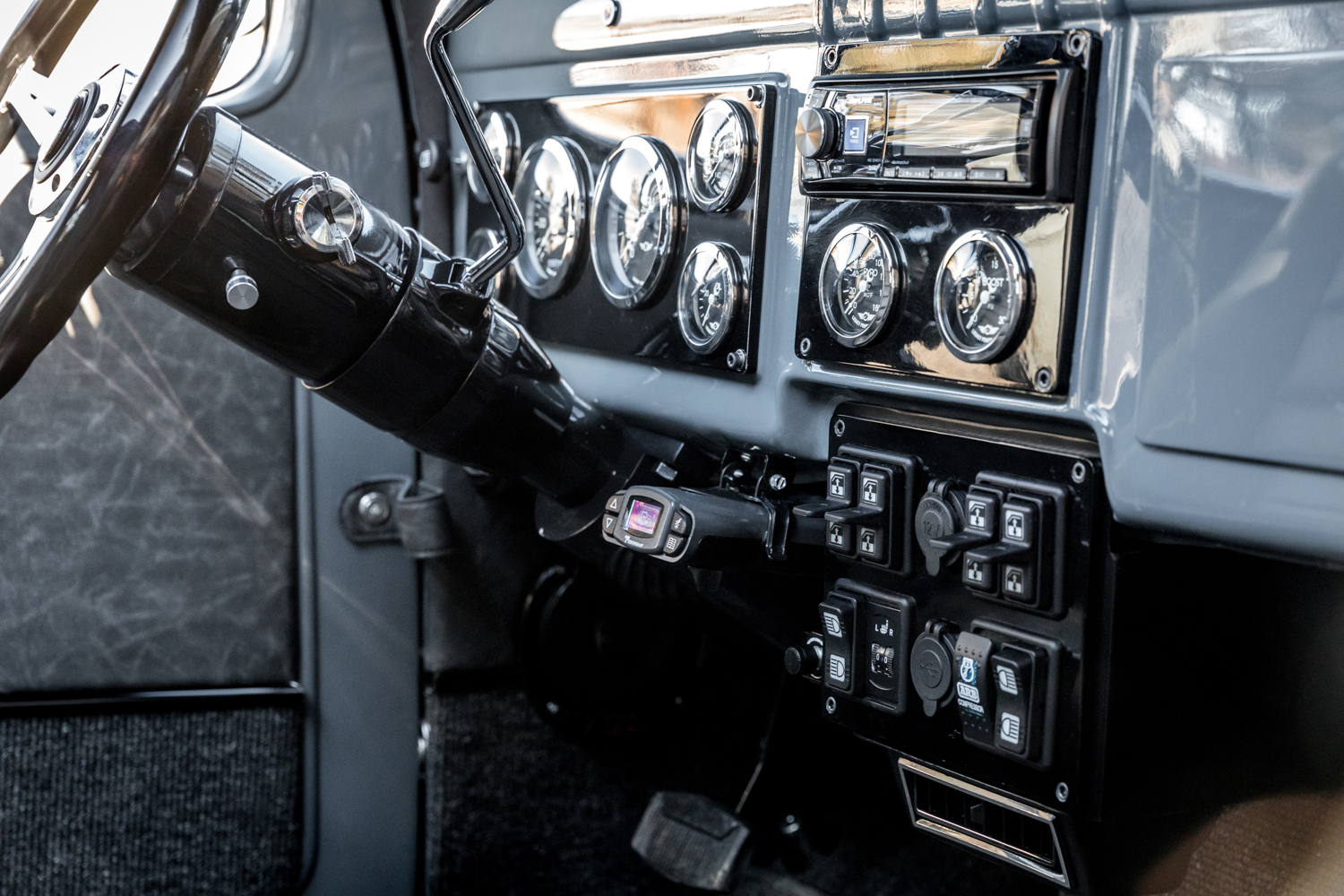Media | Articles
Driving the ultimate 1949 Dodge Power Wagon
“Oil and gas guys go nuts for this kind of stuff,” Winslow Bent says. “If you live in Canada and made a bunch of money, you’re not going to drive around in a Ferrari. And if you show up in Medford, Texas, in a Lamborghini, you’ll get your ass kicked.”
Bent is the owner of Legacy Classic Trucks in Jackson Hole, Wyoming, and the mastermind behind this $250,000 diesel-powered classic. The recipe for the unusual dish? Start with a custom-bodied crew-cab 1949 Dodge Power Wagon, then resto-mod it with suicide doors, a turbocharged Cummins straight-six diesel, and massive 40-inch Toyo tires. Think of it as a cross between a Monster Truck, the Snowman’s Kenworth, and a classic pickup, with just a little bit of Lexus thrown into the mix.
Driving his behemoth around Santa Monica is like navigating Lake George in a Carnival Cruise Liner. You can see the fear on the faces of the other motorists, mostly hipsters driving Priuses and Teslas… or is that disdain? Tourists abandon their Bird scooters and run for cover.
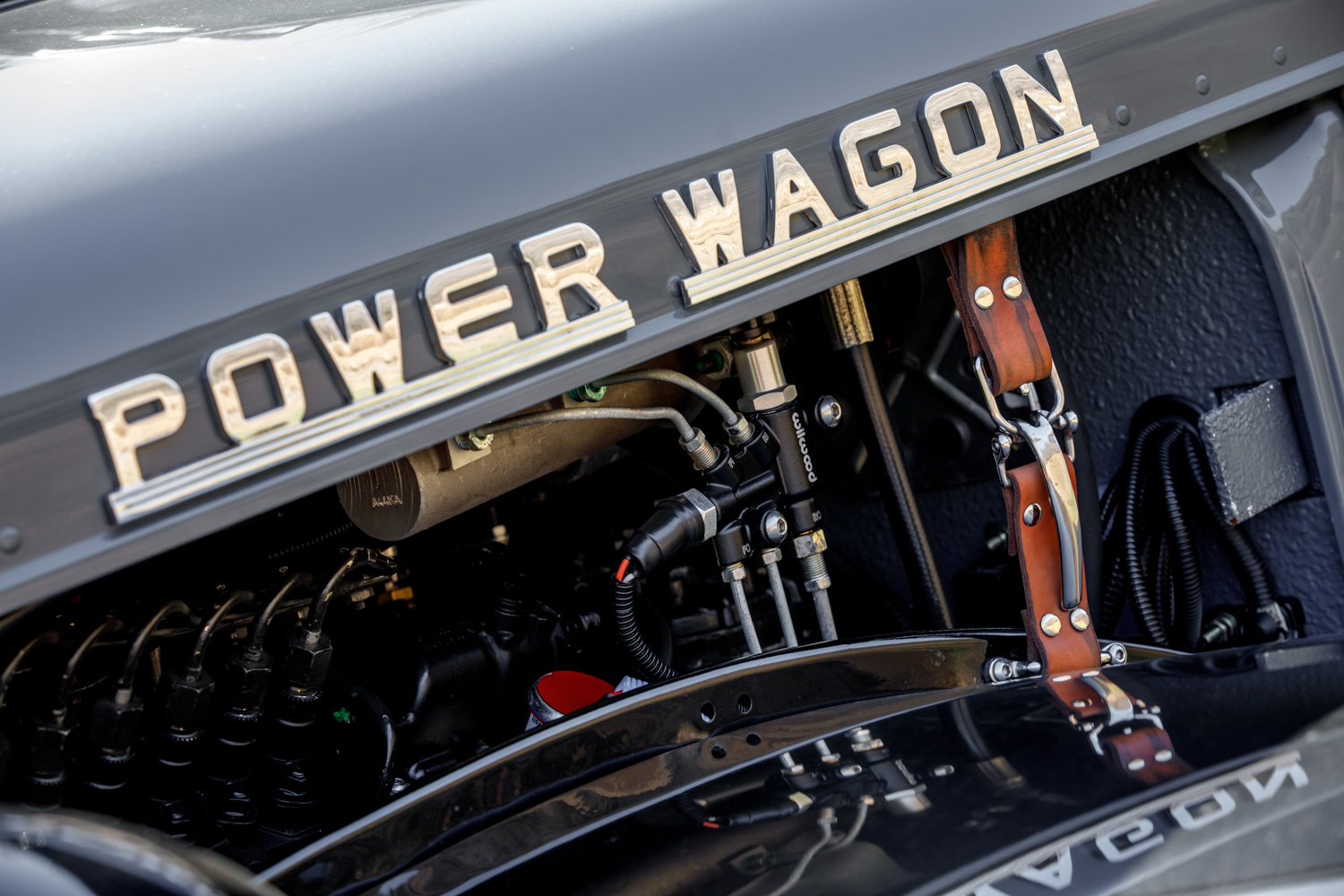

“Power Wagons spoke to me. My dad had one,” says Bent, who quit his job as a restaurant manager and started Legacy Classic Trucks 10 years ago. “It’s a labor of love.” Working out of a 10,000 square foot shop, his company now employs a dozen people and builds just about that many trucks a year, offering Power Wagons, Jeep Scramblers, and NAPCO Chevy pickups from the 1950s. So far they’ve converted 106 Power Wagons and 100 other builds.
Marketplace
Buy and sell classics with confidence
Building a beast like this one takes 18 months and about 2400 man-hours, and there’s a two-year waiting list to get started. Every nut and bolt is new and Legacy always starts with an original truck so the numbers on the frame, cab, and title match. Prices start at $195,000 and Bent has sold trucks all over the word including Dubai, New Zealand, and Morocco.
This particular truck, painted Jeep Wrangler Anvil Gray, was custom ordered by the owner of a large car dealership in Denver who uses it to tow a fifth-wheel toy box filled with snowmobiles. Bent says the truck weighs 8000 pounds and can tow up to 14,000 pounds. It’s powered by a 2002 5.9-liter inline six-cylinder Cummins diesel, so there are no electronics.
“Everything on the whole damn truck is analog,” Bent says. “That resonates with my customers. An Icon Bronco is great for cruising Malibu or Beverly Hills, but this is for cruising the wide-open spaces of the west. It’s for the ‘no coast’ crowd that wants to take it hunting.”

Although this truck has a semi-modern four-speed transmission with a lock-up converter, as well as an NP 205 transfer case, also from a 2002 Ram Heavy Duty pickup, more than half of Legacy’s builds are ordered with a manual. Bent, who has driven the truck from Wyoming to Los Angeles, says the Power Wagon gets 20 mpg with this combination, however, it’s not exactly quick, hitting 60 mph in about 13 seconds.
A lighter and more powerful supercharged LSA V-8 from GM is available, along with a lighter aluminum transmission and transfer case. At 480 pounds, the V-8 weighs about 800 pounds less than the 350-hp Cummins. And it makes nearly double the horsepower, which cuts the trucks 0–60 mph time in half.
“With the LSA it’ll spin the 40-inch tires,” Bent says. “But you can forget about towing, and the fuel economy drops to 10–11 mpg.” Both engines connect perfectly to Dana 60 front and Dana 80 rear differentials, with ARB airlockers and a 4.56 gearset.
Originally built for the military, early flat-fender Power Wagons were the first mass produced 4X4 pickup. With inline six-cylinder power and standard cabs with 9-foot beds, the one-ton trucks were eventually sold to civilians from 1946–68. They became a favorite of farmers, fire companies, and the Forest Service.


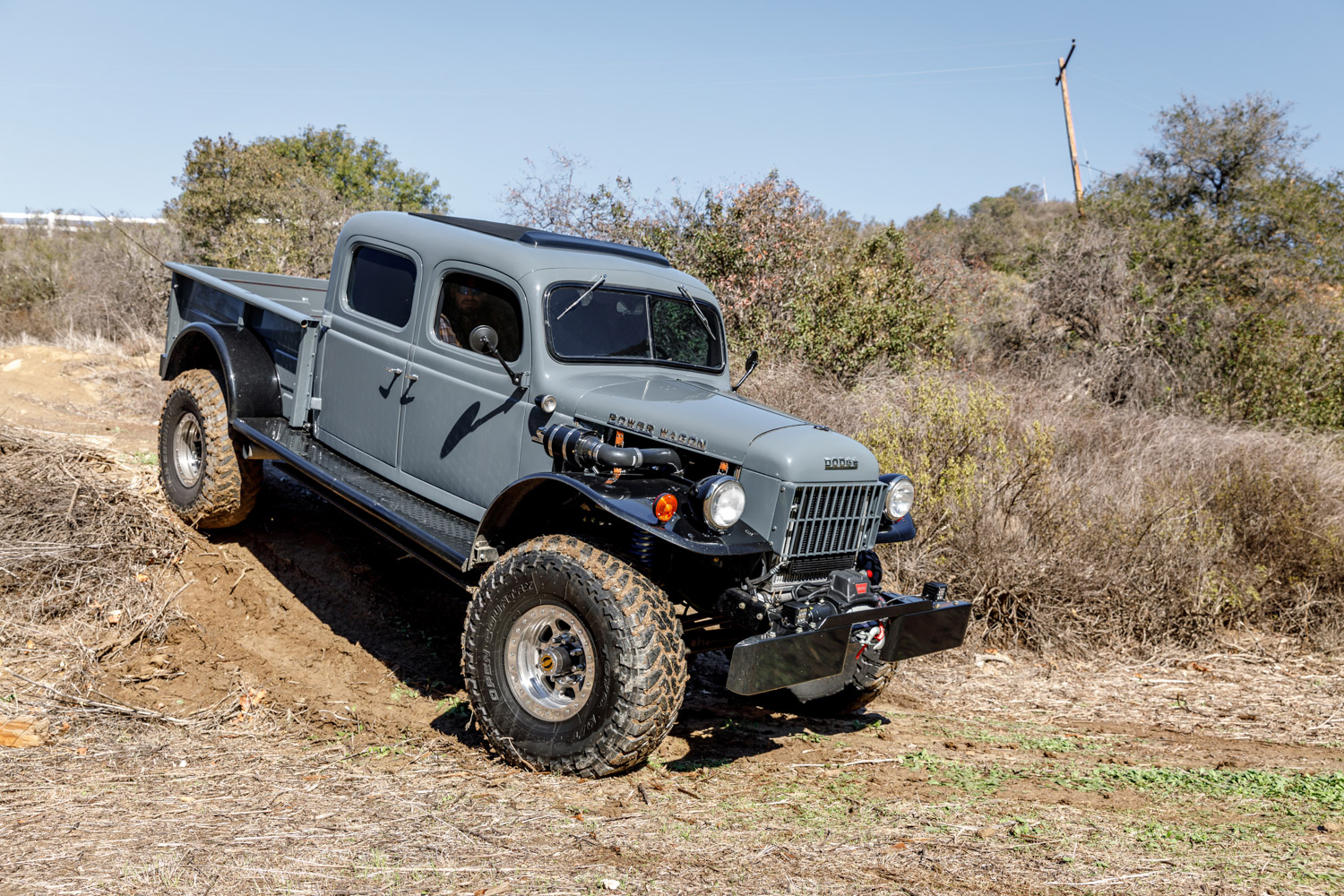
Legacy will build you a stock-bodied Power Wagon, but also offers the trucks with custom-built extended cabs or crew cabs with conventional or rear suicide doors. Coachwork on this particular crew cab took 1000 hours as Legacy’s fabricators made the roof, B-pillar, rockers, and running boards. They’ve also shortened the bed to 7 feet and re-created its rear fenders.
The front of the cab, hood, fenders, and grille are restored originals, while its rear suicide doors were created by dicing and slicing four front doors and welding the needed sections back together. Paint and bodywork takes another 1000 hours, and the craftsmanship is impressive. The panel gaps are tight and consistent, while the paint is concours quality. On the quarter-inch steel custom front bumper is a 12,000-pound Warn winch. The bed floor is African Sapele wood, a marine grade mahogany hardwood often used for guitars, home floors, and fine furniture.
With a puff of black smoke from the Dodge’s enormous tailpipe, the Cummins fires to life. It’s a noisy beast, idling at 700 rpm with a fierce growl and with an ear-piercing turbo whistle once you’re under way. Closing the windows doesn’t help. Do it anyway, since the Vintage Air air conditioning blows ice cold and the Alpine audio and navigation system has enough power to be heard over the din.
There’s also a small-diameter Grant wood steering wheel, a billet adjustable steering column from Ididit with a column shifter, and four firm, well-bolstered sport seats covered in leather and faux suede. The cab is narrow and there’s just a few inches between the front seats, but the driving position is perfect and you can cruise with your left elbow hung out on the door. Rear legroom is surprisingly tight; you’d find more space in back of a Toyota Corolla.
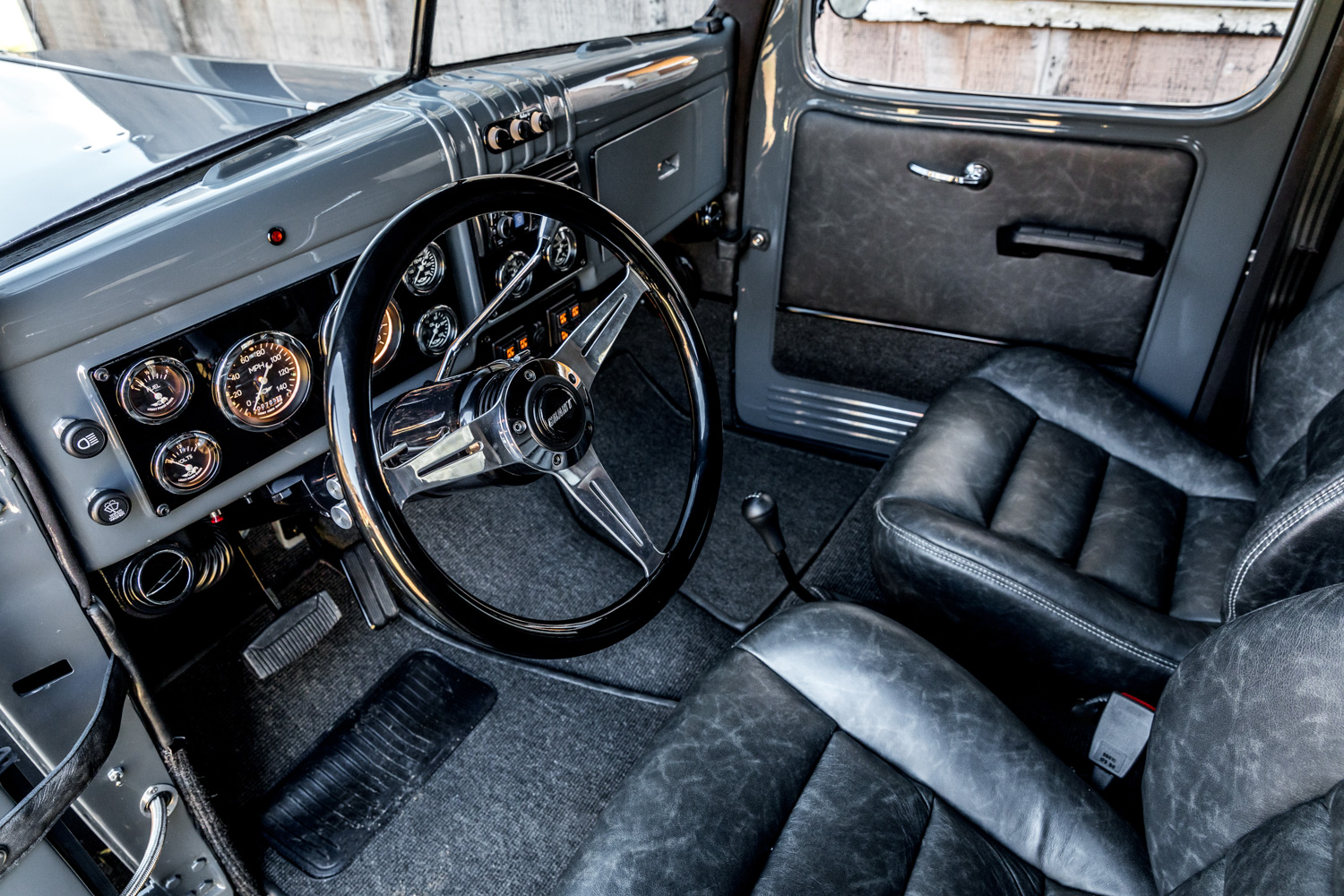
Legacy also adds full instrumentation including a turbo temp gauge, using sealed Carling marine rocker switches for the power windows and other features because they’re waterproof. They’re also oversized so you can operate them easily with gloves on. A firm called Painless supplies a new 18-circuit wiring harness.
A hanging pedal assembly is used and you can feel the engine’s vibration in your feet, but there isn’t as much of it as you would think. In fact, the refinement of this truck is incredible. Although it’s as wide as a Winnebago, has a turning radius of an aircraft carrier, and offers nothing for situational awareness besides miniscule side mirrors, it’s easy and comfortable to drive.
Were it not for the noise of the engine, it would be very quiet inside. This is by design. Legacy Dynomats the entire cab and sprays Lizardskin, a noise and heat insulation material, on the firewall and floor. “It’s everywhere,” Bent says. To best isolate the diesel from the cab, engine mounts from a forklift are used.
Also impressive is the Power Wagon’s ride quality. To achieve this the front three-link suspension is lifted 2 inches and uses beefy King coilovers with 12 inches of travel, while the rear suspension gets custom Alcan leaf springs and Bilstein 5100 shocks. It all works perfectly with the massive sidewalls of the Toyos, which are wrapped around 17×9-inch Trailready beadlock wheels. Bent uses 2018 GM truck body mounts and fabricates the floor and rockers from thick 3/16-inch steel. “Sure, it’s heavy,” he says. “But we’re not real worried about weight.”

Unlike some resto-mod trucks we’ve driven, this Power Wagon feels solid on the road, and despite its ride height it doesn’t feel tipsy in the corners. There isn’t any slop in the steering, which uses a PSC Saginaw box, and it’s nicely weighted. The stock Chrysler 1-ton brakes, which have a proportional valve and assist from a GM Hydroboost unit, are powerful and easy to modulate with a reassuring firm pedal. To help “whoa” this Goliath when towing, there’s also an exhaust brake.
With our joy ride complete, I take up two parking spaces at CVS Pharmacy and shut down the Cummins. The entire truck shudders with the final rotation of its long crankshaft. For a moment I bask in the sweet silence. “It’s important that the truck feels restored and modernized,” Bent says. “But it’s also very important to me that it doesn’t lose its soul.”
It hasn’t.
